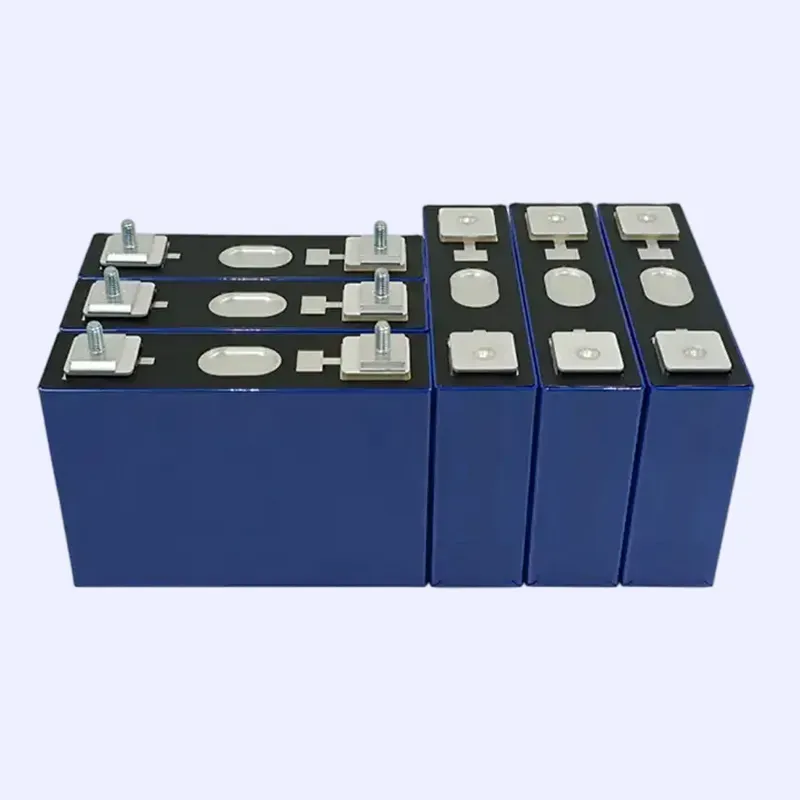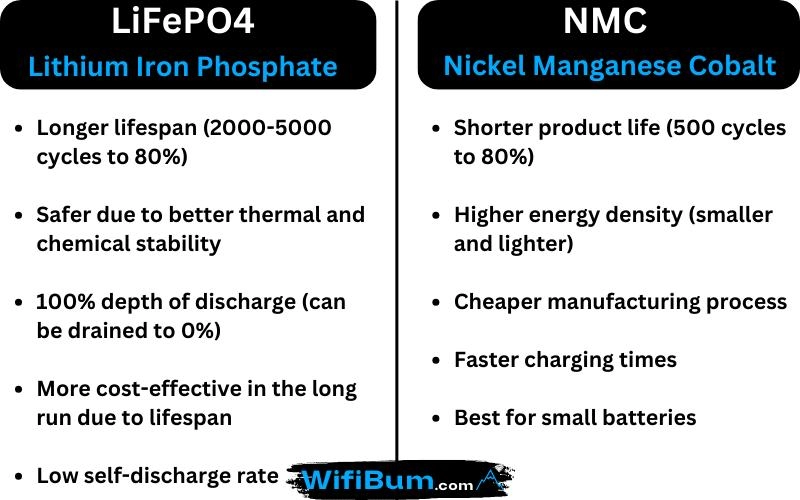LFP (Lithium Iron Phosphate) and NMC (Nickel Manganese Cobalt) batteries have emerged as two leading technologies in the energy storage landscape. Both have garnered significant attention for their unique strengths, playing vital roles in applications from electric vehicles to renewable energy systems. In this article, we will delve into the key differences between LFP and NMC batteries, highlighting their distinct characteristics, advantages, and limitations.
Part 1: Introduction to LFP Batteries

LFP batteries, or Lithium Iron Phosphate batteries, are a type of rechargeable lithium-ion battery that uses lithium iron phosphate as the cathode material. This chemistry offers several advantages over other lithium-ion types, making LFP batteries well-suited for applications demanding safety, durability, and a long lifespan, such as renewable energy storage systems, electric buses, industrial equipment, and off-grid power solutions.
Advantages and Disadvantages of LFP Batteries
Advantages:
- Long Cycle Life: LFP batteries are known for their long cycle life, often enduring thousands of charge cycles, making them a cost-effective long-term solution.
- Enhanced Safety: High thermal stability minimizes the risk of overheating or fire.
- Fast Charging: LFP batteries support fast charging, making them suitable for applications like electric vehicles.
- Wide Temperature Range: LFP batteries perform well in both hot and cold environments, offering better adaptability to various climates.
- Environmental Friendliness: LFP batteries are more environmentally friendly, as they do not contain cobalt, often associated with ethical and environmental concerns.
Disadvantages:
- Lower Energy Density: LFP batteries have a lower energy density than other lithium-ion batteries, meaning they store less energy per unit volume or weight.
- Reduced Power Density: While capable of fast charging, LFP batteries may have limitations in high-power output, affecting performance in some applications.
- Limited Availability: The availability of LFP batteries may be less than other types, which can impact pricing and accessibility in some regions.
- Relatively Larger Size and Weight: Due to their lower energy density, LFP batteries may require larger sizes and weight to achieve similar energy storage capacity, which can be a disadvantage in space-constrained applications.
- Lower Voltage Platform: LFP batteries have a lower nominal voltage compared to other lithium-ion chemistries, which may require adjustments in device design or usage.
Part 2: Introduction to NMC Batteries

NMC batteries, or Nickel Manganese Cobalt batteries, are another widely used type of lithium-ion battery. They utilize a combination of nickel, manganese, and cobalt as the cathode material, offering a unique set of advantages and considerations. NMC batteries are commonly used in electric vehicles, portable electronics like smartphones and laptops, medical devices, and power tools, as they offer a high energy density, compact size, and versatility.
Advantages and Disadvantages of NMC Batteries
Advantages:
- High Energy Density: NMC batteries are known for their high energy density, allowing them to store more energy in a smaller space or weight.
- Long Cycle Life: NMC batteries often have a longer cycle life than many other lithium-ion types, making them suitable for long-term use.
- Versatility: These batteries can be customized to meet specific energy and power requirements, making them adaptable to a wide range of applications, from electric vehicles to consumer electronics.
- Fast Charging: NMC batteries offer fast charging capabilities, reducing charging times and enhancing convenience.
- Enhanced Stability: NMC batteries offer good thermal stability, minimizing the risk of overheating and enhancing overall safety.
Disadvantages:
- Higher Cost: The inclusion of nickel, manganese, and cobalt in the cathode material leads to higher production costs, making NMC batteries more expensive than other lithium-ion technologies.
For more information on battery technology and its applications, see our guide: Comparative Analysis of Lithium Metal vs. Lithium-Ion Batteries.
Part 1: Introduction to LFP and NMC Batteries
Lithium-ion batteries have become the power source for everything from portable devices to electric vehicles. Among the various lithium-ion battery chemistries, two commonly used types are LFP (Lithium Iron Phosphate) and NMC (Nickel Manganese Cobalt). While both types offer distinct advantages, they differ in several key areas such as safety, cycle life, energy density, and application suitability. In this article, we will delve into the differences between LFP and NMC batteries, helping you understand which battery is best suited for your needs.
Part 2: Key Advantages of LFP Batteries
- Safety and Stability:
LFP batteries are known for their excellent thermal stability. This means they are less prone to overheating and experiencing thermal runaway, a serious safety concern. LFP batteries are the preferred choice for applications where safety is of utmost importance. - Long Cycle Life:
LFP batteries boast a longer cycle life, often outlasting other lithium-ion chemistries. This longevity makes them well-suited for energy storage systems and industrial applications where reliability is critical. - Cost-Effectiveness:
Generally, LFP batteries are more cost-effective than other lithium-ion chemistries in terms of production costs and long-term maintenance. Their longer lifespan also translates to lower overall costs in the long run. From a cost-benefit perspective, LFP batteries are superior. - Environmental Benefits:
LFP batteries use non-toxic, abundant raw materials, making them a more environmentally friendly option compared to some other lithium-ion chemistries. Their lower environmental impact can make them a more sustainable choice for eco-conscious applications. LFP batteries offer more environmental advantages. - Wide Temperature Range:
LFP batteries perform well in a wider temperature range compared to other chemistries. This ability to withstand extreme conditions makes them suitable for outdoor use, such as in off-grid energy systems. LFP batteries offer a wide operating temperature range.
Part 3: Key Advantages of NMC Batteries
- Higher Energy Density:
NMC batteries are known for their superior energy density. This characteristic allows them to store more energy within the same physical space, making them ideal for compact designs where space is limited, such as electric vehicles and portable electronics. - Faster Charging and Power Output:
NMC batteries are capable of faster charging speeds and higher power output. This makes them well-suited for applications that require rapid power delivery, such as electric vehicles, where quick charging is a key feature. - Production Costs:
NMC batteries generally have higher manufacturing costs than other lithium-ion batteries. However, their higher energy density and power output can justify the higher cost in applications where performance is paramount. - Performance in High-Power Applications:
NMC batteries excel in power capabilities, offering both high energy and power density. This makes them a preferred choice for high-performance applications such as electric vehicles and other power-hungry devices. NMC batteries excel in high-power applications. - Temperature Sensitivity:
While NMC batteries perform well in many environments, they exhibit temperature sensitivity to high temperatures. Prolonged exposure to high heat can lead to faster degradation, which may affect the battery’s lifespan and performance. NMC batteries exhibit temperature sensitivity.
Part 4: LFP vs. NMC Batteries: A Comparison
Safety:
LFP batteries offer higher safety due to their inherent resistance to thermal runaway. NMC batteries are generally safe, but they require more advanced safety mechanisms, especially in high-stress applications.
Cycle Life:
LFP batteries have a longer charge-discharge cycle life, making them ideal for applications that demand longevity. NMC batteries, while reliable, may require more frequent replacements.
Energy Density:
NMC batteries provide higher energy density, allowing them to store more energy in a compact size. This is highly beneficial for applications where space and weight are limited, such as electric vehicles.
Power Density:
LFP batteries have excellent power density, capable of delivering energy quickly when needed. This makes them suitable for applications that require rapid energy release, such as certain industrial uses.
Temperature Resistance:
LFP batteries perform better in extreme temperatures, ensuring stable operation in both freezing and scorching environments. NMC batteries, on the other hand, degrade faster when exposed to high temperatures.
Power Capability:
NMC batteries offer high power output, making them ideal for fast-charging applications and those requiring quick bursts of energy. LFP batteries, while robust, may not deliver the same peak power as NMC batteries.
Application Suitability:
LFP batteries are commonly used in stationary applications, such as energy storage systems, where safety, long cycle life, and stability are paramount. NMC batteries are often found in electric vehicles, portable electronics, and other applications where space and power are critical.
Part 5: How to Choose Between LFP and NMC Batteries?
- Application Type
- LFP Batteries: Best suited for energy storage systems, solar power installations, and industrial equipment where safety and longevity are paramount.
- NMC Batteries: Ideal for electric vehicles, portable electronics, and devices that require a compact design and high energy output.
- Budget
- LFP Batteries: Offer better cost-effectiveness over time due to their long lifespan and low maintenance needs.
- NMC Batteries: While the initial cost is higher, the performance benefits, such as higher energy density and power output, justify the investment.
- Energy and Power Needs
- LFP Batteries: Suitable for applications that require a stable, long-term energy output, such as renewable energy storage or backup power solutions.
- NMC Batteries: Best for applications that demand high power and energy density, such as electric vehicles or high-performance electronics.
- Environmental Conditions
- LFP Batteries: Perform well in harsh environments and extreme temperatures, making them suitable for outdoor and rugged applications.
- NMC Batteries: While reliable, they require careful thermal management and are prone to faster degradation in high-temperature environments.
- Safety Requirements
- LFP Batteries: Are the safer option in situations where thermal stability is critical, such as residential energy storage and industrial applications.
- NMC Batteries: Are safe for most applications but require additional safety measures in high-risk scenarios.
By understanding the differences between LFP and NMC batteries, you can make an informed decision based on your specific needs. Whether you prioritize safety, performance, or environmental impact, both battery types have their strengths and can effectively serve a wide range of applications.
Sustainability and Environmental Impact
LFP Batteries:
LFP (Lithium Iron Phosphate) batteries are considered more environmentally friendly because they use a cobalt-free design and have a smaller ecological impact during production. Their carbon footprint is generally smaller.
NMC Batteries:
NMC (Nickel Manganese Cobalt) batteries raise more environmental concerns due to the use of materials such as cobalt and nickel. The extraction of these materials requires careful sourcing and effective recycling measures to minimize environmental damage as far as possible.
Ultimately, the choice between LFP and NMC batteries depends on striking a balance between safety, energy requirements, cost, and environmental factors. Consulting a battery expert can help you optimize your decision to find the battery that best suits your needs.








